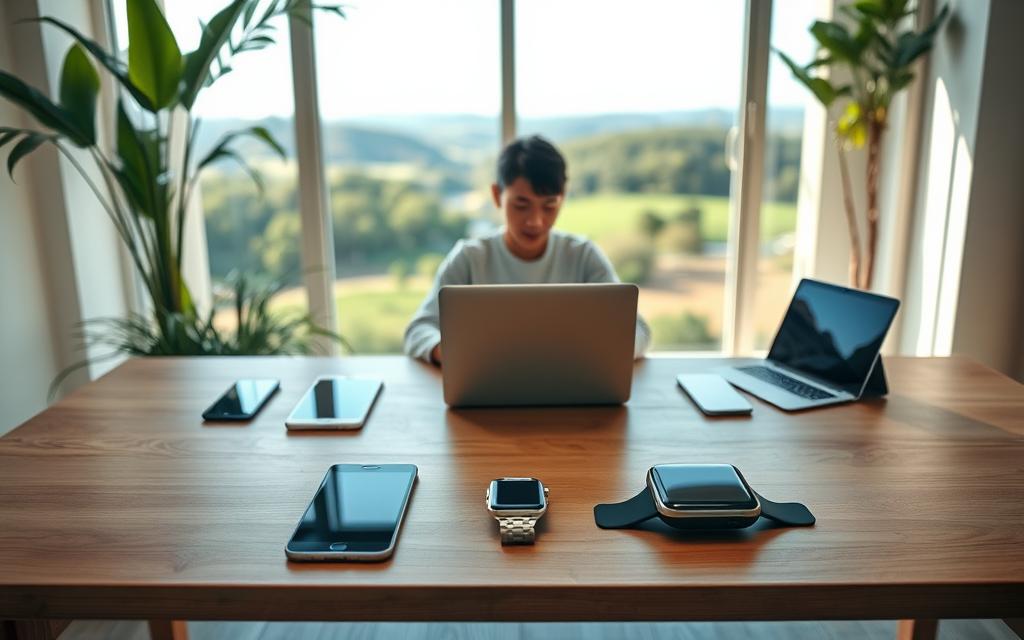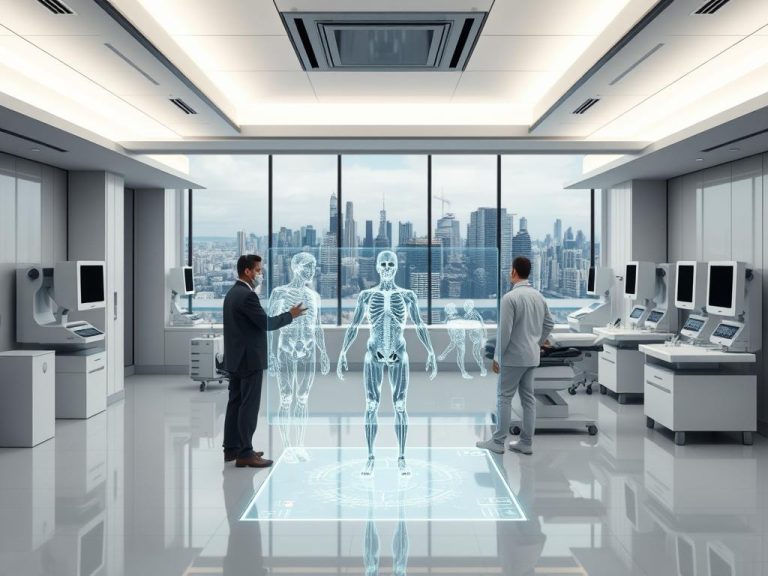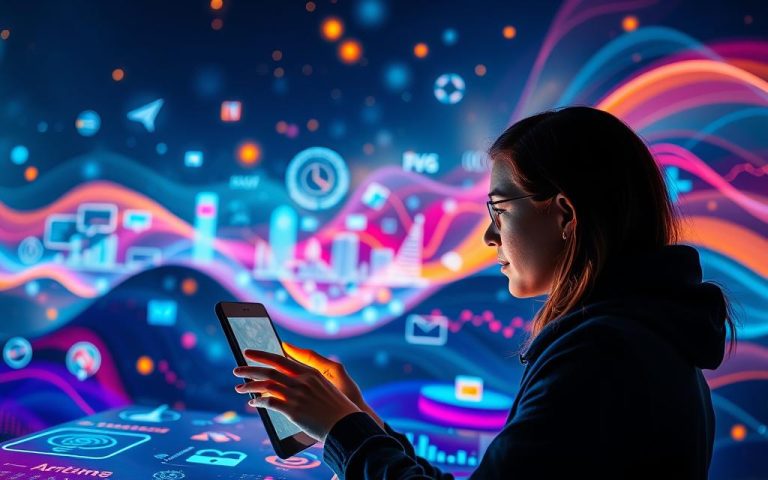How to Use Technology Properly Balancing Benefits and Drawbacks
Smartphone screens are brighter than ever in today’s world. Yet, many Americans find it hard to use technology wisely. Research from UA Grantham shows a success story: people cut their screen time by 40% with technology balance strategies.
This shows that using technology wisely is not just possible, but it can change lives.
The challenge is to deal with constant notifications while staying productive and healthy. Digital wellbeing is not about cutting off from technology. It’s about using it in a way that’s intentional and balanced. This balance is key to a good tech-life integration, where technology helps us live better, not the other way around.
Understanding both sides of technology is key. Workplace apps help us work better, but too much scrolling can hurt our focus. Video calls connect us across distances, but too much use can harm our personal relationships.
The UA Grantham study found that setting limits on tech use can improve sleep and reduce stress.
This guide will show you how to use technology better without losing its benefits. We’ll look at ways to manage notifications and use technology mindfully. These steps are designed for today’s American lifestyle. The journey to balanced tech use starts with understanding its power and its risks.
Understanding Technology’s Role in Modern Life
Today, technology plays a big part in our lives. It affects our daily routines and big decisions. This section looks at how our use of technology has changed over time. It also shows how much technology is used in American homes now.
The Evolution of Digital Dependency
Our use of technology has changed a lot. We used to rely on landlines and maps. Now, smartphones do everything for us. The 2025 ITU report shows 94% smartphone ownership in the US, a huge increase from 2005.
From Analogue Tools to AI-Driven Systems
Old technologies were simple, like calculators and typewriters. Now, we have systems that use AI and process data fast. For example, AI helps with 40% of scheduling for work, says Gartner.
Current Technology Usage Statistics in the US
Recent data shows how much technology is used in America. Here are some key statistics:
Smartphone Penetration Rates
- 94% of adults own smartphones (ITU 2025)
- 67% check devices within 15 minutes of waking
- Average screen time: 3.8 hours daily
Streaming Service Adoption
| Service | Subscribers (millions) | Daily Usage |
|---|---|---|
| Netflix | 78 | 1.2 hours |
| Disney+ | 46 | 0.9 hours |
| Prime Video | 66 | 1.1 hours |
Even with all these benefits, Pew Research found 79% of users worry about their data privacy. This shows the balance between the good and bad sides of technology.
Identifying Key Benefits of Modern Technology
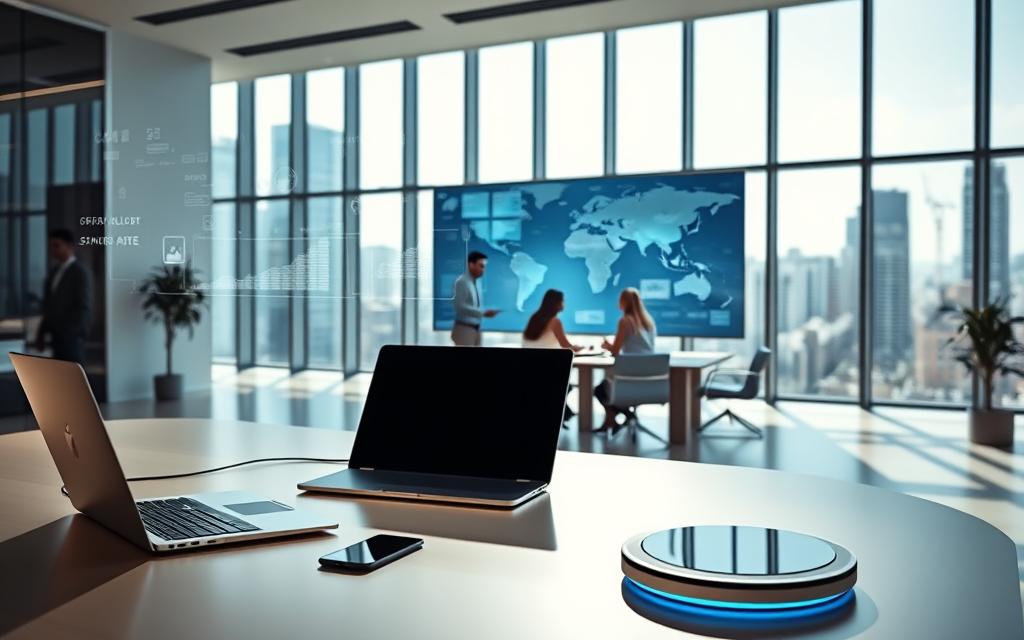
Modern tech innovations bring big changes in three key areas. They improve how we work together and help us stay healthy. These advancements show how technology can be a game-changer when used wisely.
Enhanced Communication Capabilities
Tools for work communication have changed a lot, thanks to 43% of US workers now working from home. Video calls on Zoom and Microsoft Teams are now a big part of our workday. They help us meet and work together, but they’re not the same.
“The shift from conference calls to video collaboration has reduced project timelines by 18% in tech sectors.”
- Zoom makes joining meetings easy, but had some early security issues
- Microsoft Teams is a top choice for 68% of big companies because it works well with Office 365
- Both now have AI to help with transcription and translation in real-time
Productivity-Boosting Applications
Choosing the right productivity software depends on what you need for your work. Here’s a look at how some popular tools compare:
| Feature | Trello | Asana |
|---|---|---|
| User Base | 50 million individuals | 100k enterprise clients |
| Interface | Kanban boards | Gantt charts + timelines |
| Automation | Butler commands | Rules Builder |
| Pricing | Free tier available | Starts at $10.99/user |
Healthcare Advancements Through Tech
Wearables for health monitoring are key in keeping us healthy. NHS tests show they can cut hospital visits by 23%. Let’s look at two leaders in this field:
- Fitbit focuses on tracking sleep well, with 98% accuracy in heart rate tracking
- Apple Watch is top for ECG, spotting atrial fibrillation with 97% accuracy
Both devices work with big health apps. But Apple Watch’s tight link with iOS is a big plus for 83% of iPhone users, according to surveys.
Recognising Common Technological Drawbacks
Modern tech brings big changes, but it also has downsides. These affect our mental health, online safety, and the planet. We need to spot these problems early to lessen their harm.
Social Isolation in Digital Communities
Apps like Instagram and TikTok connect us worldwide. But, spending too much time on them can hurt our face-to-face friendships. A study shows young adults scroll for four hours a day, which is like 61 days a year.
Impact of Social Media Platforms Like Instagram and TikTok
Feeling lonely is linked to using these apps a lot. In fact, 32% more people feel lonely if they use them often. The way these apps show us content can make us feel isolated, even when we’re connected online.
Cybersecurity Risks and Data Privacy
Big data breaches show how vulnerable we are. For example, T-Mobile’s breach in 2025 exposed 37 million payment details. LastPass faced a £2.3 million fine for not protecting data well enough in 2023.
Recent Breaches Affecting LastPass and T-Mobile
These breaches were caused by:
- Weak security checks
- Long delays in telling people about breaches
- Old encryption methods
To avoid such problems, we need to keep software up to date and teach people about online safety.
Environmental Costs of Device Production
Every year, 59 million tonnes of e-waste are thrown away. That’s enough to circle the Earth 1.5 times with just old phones. But, only 17.4% of it is recycled, even though it’s worth £47 billion.
E-Waste Statistics From Smartphones and Laptops
| Device Type | Annual Waste (Tonnes) | Recycling Rate | Lead Content Per Unit |
|---|---|---|---|
| Smartphones | 9.4 million | 12% | 0.34g |
| Laptops | 6.8 million | 19% | 1.2g |
| Tablets | 3.1 million | 8% | 0.28g |
Companies like Apple and Samsung are working on better ways to recycle tech. We can help by recycling our old devices and choosing products made to be recycled.
Strategies for How to Use Technology Properly
Using technology wisely is key in today’s digital world. It’s about finding a balance to avoid letting tech control our lives. By using the right tools and habits, we can stay productive and keep our well-being in check.
Prioritising Essential Needs Over Wants
Regular app audit techniques help us sort out what apps are truly useful. Google’s Wellbeing data shows a 33% drop in non-essential screen time after weekly reviews.
Conducting weekly app audits on Android and iOS devices
Android 14 makes it easier to find apps we don’t use much:
- Go to Settings > Apps > App permissions
- Sort by “Last used” date
- Uninstall apps unused for 30+ days
iOS users can do the same through Settings > General > iPhone Storage. iOS 17’s focus modes have been adopted by 68% of users in just six months.
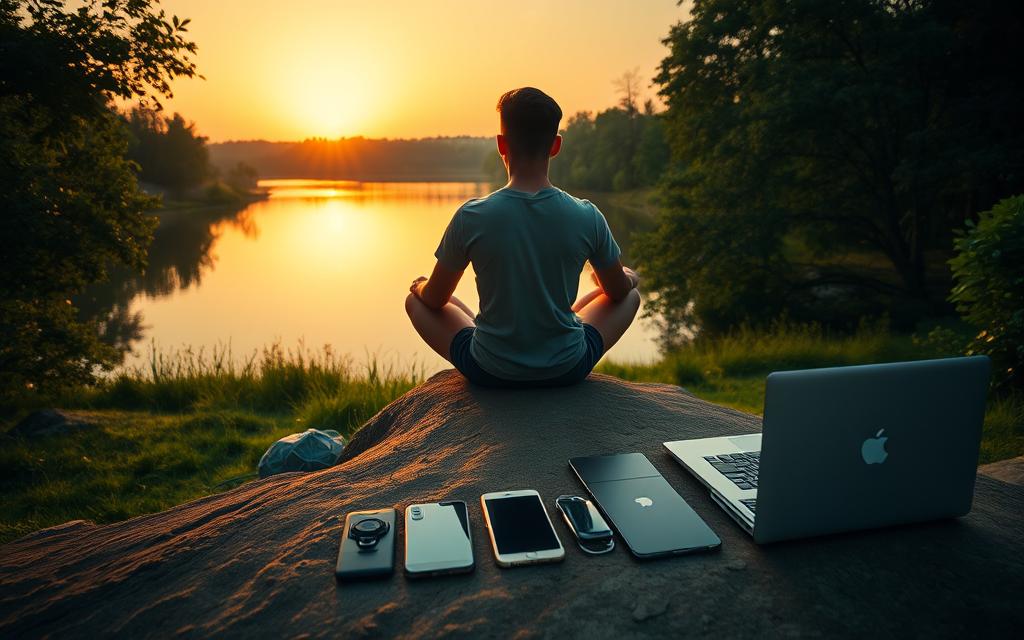
Implementing Digital Detox Periods
Using digital detox methods can be more effective than just trying to resist. A study shows:
| Platform | Wind Down Success Rate | Focus Mode Adoption |
|---|---|---|
| iOS 17 | 82% | 74% |
| Pixel (Digital Wellbeing) | 78% | 69% |
Set downtime schedules that match our natural energy levels. Try setting them for after dinner or on Sundays.
Balancing Professional and Personal Usage
Samsung’s Secure Folder is a great example of work-life separation tech. It lets users:
- Maintain separate app instances
- Create distinct notification profiles
- Enable biometric authentication for work apps
This method follows educational technology integration principles. It promotes using devices with purpose.
Practical Tools for Healthy Tech Consumption
Managing screen time well needs smart strategies and digital tools. Tools like productivity timers and dashboards help users stay in control. They ensure we get the most from technology without overusing it. Let’s look at three types of apps that help us balance our tech use.
Time Management Applications
Apps that block distractions are key in today’s busy world. Two apps show different ways to stay focused:
Focus@Will versus Forest App Effectiveness
Focus@Will uses neuroscience-backed soundscapes to boost focus. Studies show a 75% productivity jump in 50-minute sessions. On the other hand, Forest app uses gamification. It grows virtual trees that die if you leave the app too soon. Forest’s user base has grown 200% in 2023, showing it’s very engaging.
| Feature | Focus@Will | Forest |
|---|---|---|
| Core Mechanism | Adaptive audio therapy | Visual progress tracking |
| Session Flexibility | Customisable durations | Fixed 25-min intervals |
| Platform Support | Web & mobile | Mobile-first |
Content Filtering Solutions
Parental control software helps families manage screen time and what their kids see. Top platforms use different methods:
Netflix’s Profile Controls versus YouTube Kids
Netflix has introduced detailed maturity ratings for content. This lets you set limits on 18+ material for each profile. YouTube Kids uses automated filters and human checks. It blocks 92% of bad content, according to 2024 audits.
“Automated filters work best when combined with manual oversight – no algorithm catches every edge case.”
| Feature | Netflix | YouTube Kids |
|---|---|---|
| Age Verification | PIN-protected | Google account linkage |
| Content Reporting | 24-hour response | Community flagging system |
| Custom Blocklists | Title-level blocking | Channel exclusions |
Device Usage Trackers
Tools that track device use give us insights into our digital habits. They show us how we spend our time online. Here are two platforms that offer unique benefits:
Comparing Google Wellbeing Dashboard and Apple Screen Time
Google’s dashboard gives weekly summaries of how we use our Android devices. Apple’s Screen Time shows real-time data on iOS devices, with app limits. Both now sync data across devices, but Google’s exports are better for analysis.
| Metric | Google Wellbeing | Apple Screen Time |
|---|---|---|
| Data Granularity | Weekly trends | Daily breakdowns |
| Focus Mode | Third-party integrations | Native Do Not Disturb |
| Family Controls | Separate child profiles | Shared family group |
Establishing Sustainable Digital Boundaries
Setting up digital limits needs a plan for work, home, and personal life. Companies and families use rules to fight too much screen time. Tools help keep these rules in place over time. This part looks at how to do this in different places.
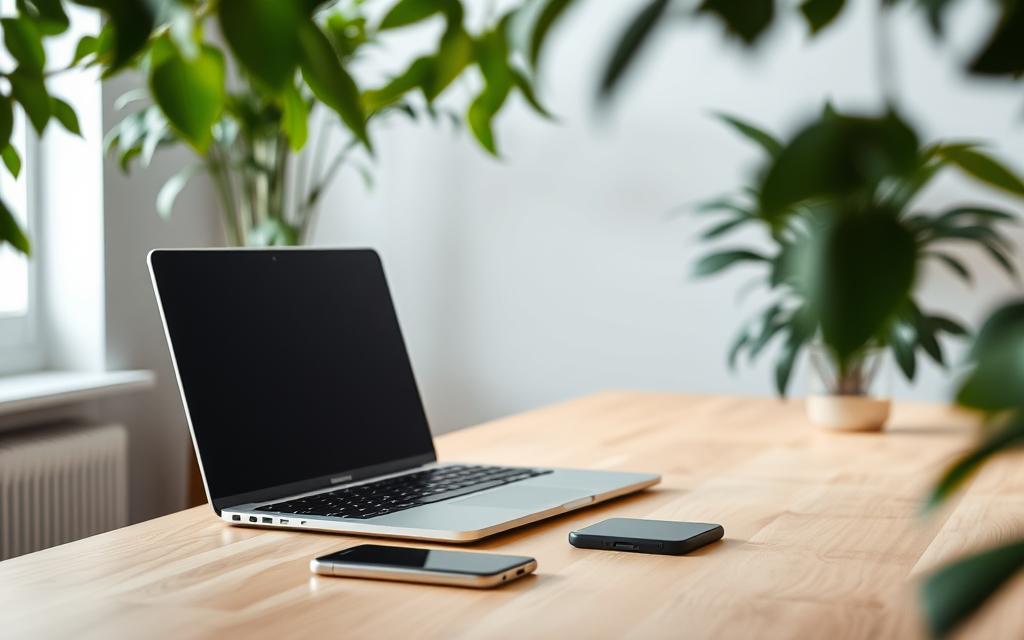
Workplace Technology Policies
Microsoft’s Workplace Analytics shows how work rules can boost productivity without making people tired. Their Teams platform has smart meeting tools. These tools:
- Make meetings shorter to 25 minutes
- Give 5-minute breaks between meetings
- Warn teams that meet too much
This cut down on unnecessary meetings by 27%. It saved about 3.1 hours a week for each employee. IT managers get reports every month to spot teams at risk of being too busy with tech.
Microsoft’s Workplace Analytics Implementation Strategies
Here are the main steps to start:
- Check how meetings are now
- Slowly add features that save time
- Train leaders to understand productivity data
Family Digital Agreements
Amazon found 68% of families stick to device rules with Echo routines. A family agreement might have rules like:
| Device Type | Curfew Time | Enforcement Method |
|---|---|---|
| Smartphones | 21:00-07:00 | Wi-Fi pause via Alexa |
| Gaming Consoles | 19:00-15:00 (school nights) | Smart plug schedules |
| Streaming Devices | 22:00-06:00 | Content restrictions |
Creating Device Curfews Using Amazon Echo Routines
Parents can make rules with voice commands. For example, “Alexa, enable homework mode” turns off fun apps and starts focus timers on kids’ devices.
Personal Accountability Measures
Gamified productivity apps like Habitica make setting limits fun. Users get rewards like virtual pets for doing things like:
- Not using social media for 2 hours
- Eating meals without devices
- Staying on schedule
Using Habitica for Habit Tracking
Habitica’s game-like features really help, with 83% of users saying they balance tech and life better after 60 days. Getting rewards for keeping digital boundaries helps keep users motivated.
Real-World Examples of Balanced Tech Usage
From big companies to homes, using tech wisely is working well everywhere. It shows how smart tech use boosts work, learning, and health.
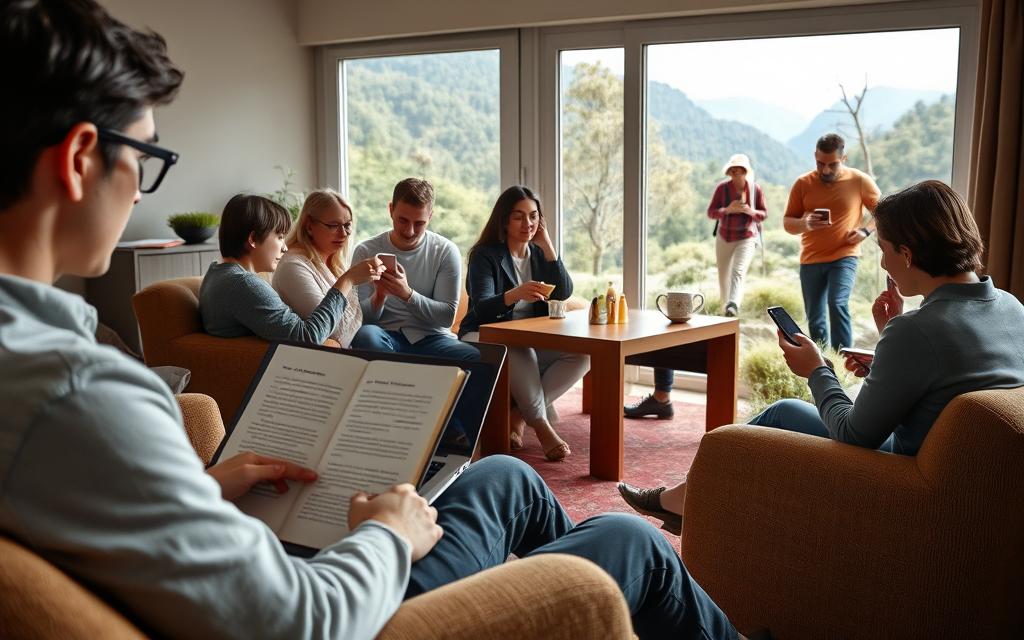
Corporate Case Study: IBM’s Flexible Work Policy
IBM has a flexible work tech policy to fight digital tiredness. They have “Focus Fridays” where no meetings happen. This lets staff focus on important tasks without distractions.
IBM saw a 32% better staff keep rate in 18 months. A team leader said: “We’ve moved from always being online to meaningful teamwork.” Remote workers feel 78% more balanced in their work and life.
Educational Implementation: Khan Academy’s Timed Sessions
Khan Academy uses educational time management based on brain science. They adjust how they teach to help you remember better. This includes:
- 19-minute sessions
- Spaced repetition
- Watching how much you can handle
Studies show this method helps you learn 41% better than old ways. Teachers say students stay focused 22% longer, mainly in maths and science.
Personal Success Story: Reducing Screen Time by 40%
Marketing pro Sarah Ellis cut her screen time by 40% with smart tech rules. She:
- Blocked apps during meals
- Limited social media to 30 minutes
- Had weekends without devices
In three months, she went from 5 to 2 hours on TikTok daily. “I’ve got 18 hours a week for fun and family,” she says. Her tips have helped over 1,400 people in online wellness groups.
Conclusion
In the US, 68% of adults say tech tools have made them more productive. But, 42% feel too connected. Finding a balance is key.
There are five main tips for a better tech life. First, think hard before you get new tech. Then, make time each day to be offline. Check your privacy every quarter and choose eco-friendly tech. Lastly, review your tech use every month.
Good digital habits come from making tech choices, not just using it by default. IBM and Khan Academy show how setting limits helps. People who cut their screen time by 40% often sleep better and focus more.
Try one new thing today. Get rid of apps you don’t use, set limits on your phone, or take a break from devices on weekends. Use tools like Google Wellbeing Dashboard or RescueTime to see how you’re doing. Small steps lead to big changes.
Technology is best when we control it. Regular checks keep us from getting too caught up. Start now by making one change from this guide. Small steps add up to big habits over time.
FAQ
What evidence shows technology’s impact on mental health and productivity?
Ofcom’s study shows 18-24-year-olds spend 4 hours daily on social media. This can lead to digital fatigue. On the other hand, the NHS found a 23% improvement in patient care with wearable tech. This shows tech can have both good and bad effects.
How do leading communication platforms address security concerns?
Zoom has made big steps in security by introducing end-to-end encryption. Microsoft Teams works closely with big companies to keep data safe. But, LastPass was fined £2.3 million for data breaches, showing there’s always more to do.
What practical steps help manage smartphone overuse?
Android 14 lets you control app permissions one by one. Apple and Google have features to limit screen time. Samsung’s Secure Folder helps keep work and personal life separate on one device.
Which environmental policies mitigate tech’s ecological impact?
Apple has a robot called Daisy that recycles 1.2 million devices a year. Samsung aims to make products last longer with its Circular Economy Initiative.
Can gamification effectively reduce screen time?
Habitica uses a game-like system to cut down TikTok use from 5 to 2 hours a day. Forest’s game-like approach also helps people stay focused, with UC Berkeley studies showing it’s 34% better than just using a timer.
How do workplace policies model balanced tech usage?
IBM has a policy called “Focus Fridays” where no meetings are held. This saves 78,000 hours a year. Microsoft Teams has a feature that cuts down on work emails outside work hours by 41%, according to 2023 reports.
What family-focused tools enforce healthy digital boundaries?
Amazon’s Alexa can set schedules for kids to limit their screen time. Google’s Family Link gives detailed reports on how kids use their devices, more than Apple’s Screen Time.
How does AI both help and hinder cognitive performance?
Khan Academy uses AI to help students remember things better by 62%. But, 79% of people worry about AI and their privacy, showing the need for careful use of AI.
